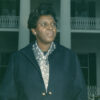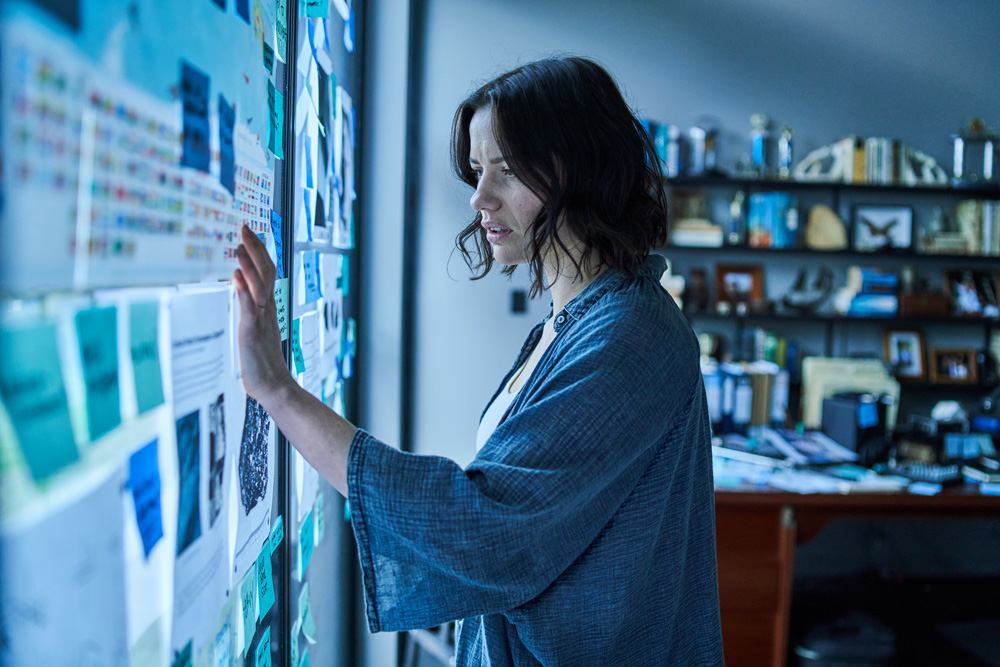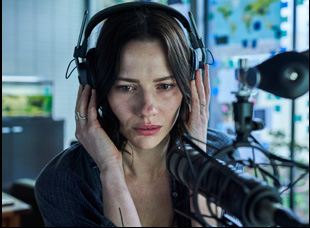The unnamed podcaster (Lily Sullivan) at the center of “Monolith” knows how to keep listeners in their seats, which in turn has made her unable to leave hers. In spite of some recent controversy — or perhaps because of it — involving someone cleared of all charges who nonetheless was made a villain on her show “Beyond Believable,” she is eager to give her audience more stories that are stranger than fiction and believes she’s come across one upon receiving an anonymous e-mail with a name, a date and a mention of a mysterious brick. A call to Floramae King, the one-time housekeeper referenced in the e-mail, isn’t all that promising, but as a self-described practitioner of “high-quality journalism” without going so far as to call herself a journalist, the dogged amateur sleuth is eager to turn over every stone to tell a juicy story, encouraged that she has something to work with when she makes contact with a German art dealer who is convinced that the brick is proof of alien life.
Whether or not the podcaster is onto something bigger becomes the driving force of “Monolith,” but there’s no doubt throughout that director Matt Vesely is, crafting a compelling mystery with writer Lucy Campbell that doesn’t only raise questions about humans being the only intelligent life in the universe, but if this particular podcaster is responsible enough to handle delivering the news. As the podcast gains traction, popularity also brings skeptics who start to pick the narrative apart and plead with her to stop and the film finds her simultaneously emboldened and fearful of pursuing the truth when the attention it brings clearly has consequences both good and bad. With an electric lead performance from “Evil Dead Rise” star Sullivan, who never lets you question the allure of the podcast despite never seeing the outside world, “Monolith” meets its lead with constantly dynamic cinematography and crafty plotting that is equally bound to leave you hanging on its every word and after showing a wicked sense of humor with his short “System Error,” Vesely appears just plain devious in his feature debut, following the podcaster down a path she may not be able to talk her way out of.
Following a celebrated premiere last spring at SXSW, the film is arriving in select theaters and on demand this week and Vesely generously spoke from his home in Australia about how limitations of a sparse budget enabled creativity for the thriller, finding the right landscapes physically and sonically to place the film in and finding the right scene partner for what’s ultimately a one-person show.
It was part of a lab called Film Lab New Voices program, which the South Australian Film Corporation and Adelaide Film Festival ran and myself, Lucy Campbell, the writer, and Bettina Hamilton, the producer, applied [with a pitch] and the idea is you would develop a project over the course of a year within this lab, and if you get to the end of the lab and you’re successful, you’ll get production financing, but you know that it’s going to be quite small. So we developed “Monolith” for that lab with the [thought] of what can we make that’s going to be more interesting because it has a small budget, not only to be achievable, but also define it or make it exciting. It’s a thrilling way to develop something when you know what the production is going to look like. You can be really careful and make really specific choices about what you’re going to do so that you’re not squeezing a film in and having to compromise. It’s really building upwards and outwards, so on set, it just felt like we had everything we needed. We were super planned. We weren’t rushed. It was really good.
One of my favorite things about this is how the light and this house, which its big windows, creates such vitality throughout the film. What it was like to find a location for this?
Originally, it was scripted to be on the coast of South Australia. We have these amazing coastlines with these great limestone cliffs and as it was originally written, it’d be like looking out and the ocean creeping in would create a sense of isolation. But we went to look at some homes and we couldn’t find anything [like that]. They had beautiful views and they were great homes to live in, but cinematically, they weren’t super striking and a big part of the film, as the film goes along, is that our character comes from wealth and immense privilege, so you need this moment where you step out of the recording booth into the house for the first time and you instantly go, “Holy shit, look at this house.”
Our locations manager Scott McCarten, this amazing guy who’s super resourceful, used to be an urban explorer, so he knows all the underground places in Adelaide to go and how to get into the sewers and stuff. I said, “Don’t worry about the coast. We’ll ditch that. Just find this house that’s going to do that stuff for us.” And he found a video online from an architecture firm about the build of the house, showing it off and he had to combine that with Google Maps to work out where, where it was and then just went up and rang on the door. They let him in and the rest is history. They were a beautiful family that was really kind to offer the home to us. And the amount of glass just means that there’s not only light and angles you can work with, but there’s this feeling that she’s being watched the entire time. She’s so exposed, even though she’s so isolated, [it feels like] man, anything could be out there, so that’s a big character in the film.

We knew she had just shot “Evil Dead,” and it hadn’t come out yet, but obviously that’s an exciting project, so we [thought], “Okay, that’s cool” and we knew she was a fantastic actor. Her agent was the one who recommended her to us, but I knew her work and we didn’t audition her. We just interviewed her because it’s a small film and you want your cast to really be up for the challenge. They can’t really be separate from the crew. They’ve got to be really in amongst it. Lily seemed really excited by that. She is so down to earth and just a really genuine person, and coming off such a physical movie to do something so contained was exciting, but also what a challenge to do. You’re going to be the only person on screen and it’s almost like a play. We’re going to shoot it chronologically and so much of the film is interviewing people on the phone. And she really likes to feel it. She doesn’t like to think it, so she would do like pushups before the take to get the adrenaline going in her body, and then stand up and take the phone call, so that was really interesting.
Working out what an actor needs is a really fun part of directing, [and occasionally] we let her call “action” because she’s supposed to be alone in this house and it’s so hard to feel alone and isolated when there’s a crew around. It’s quite noisy and it’s all happening, so what we ended up finding after a few days was if we called “roll camera and roll sound, and speed and set” and do makeup checks and all that stuff, we’d just sit there and the crew would go silent and we’d give the set to Lily, she would just do whatever she needed. She’d pace or do her pushups or just sit in silence for a couple of minutes and she’d just give a little nod to the first AD who’d then call “action” and man, it helps so much. It allowed her to block everything out and just like get back to the scene and the performance and then go from there.
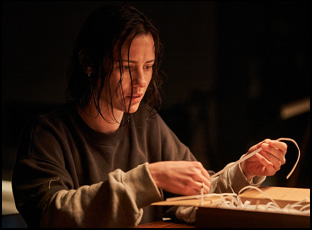
Definitely experimented more in post for sure, but we were pretty specific about it. We didn’t have a lot of time. Leigh [Kenyon] did the sound design for “System Error,” and Ben [Speed], the composer, did my previous short, so I had a good relationship with them and we could work quite quickly and I could be quite specific and then let them go from there, and that was really important. [There was] a blurring of the line between the music and the sound design because Ben was recording found sounds and building them into the texture of his music. It’s quite atonal. It has some melody, but it’s also just got a lot of texture and feeling to it, so they were having to talk to each other and figure out what was what a lot of the time. We always wanted to keep the audience unsettled.
Because the film looks quite objective — there’s a sense of observation of the camera’s always a bit removed from her and watching her through glass, which adds to the kind of the horror, it was important that the sound could be more subjective and get into the world of the character. It’s much more expressionistic in that way. In sound design, the alien artifact has a really specific sound that we’d always talked about. It’s actually in the script [where it’s described how] you can kind of hear this rumbling, so Lee and I found that sound and then worked out ways we could build it through the film where it could come in and out, and in the edit, we’d put temp music in and then give that to the composer, to [say] “This is where I’m thinking there might be music,” and all I had in there was these taiko drum sounds I’d ripped off YouTube — big thunderous drums that could put under these relatively banal scenes — that would give them this unsettling feeling. Ben took some of that, but changed a lot of it, and I just wanted the audience to constantly feel like they’re not quite sure even what we as filmmakers are saying to them if they read too much into it.
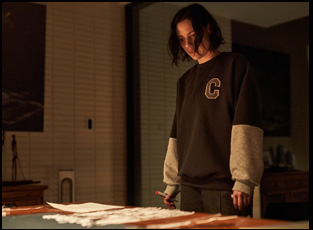
It was a big lesson to learn. George [the robot from “System Error”] is actually still in my room, and the way we did “System Error,” the voice triggered the light [on the robot], so I had to record the dialogue before and the late Nick Nemeroff, a wonderful friend of mine who passed away and played George, I recorded that with him in advance and I edited it. Then on set Dave, who played the human character, was having to act opposite a recording. That’s not great for an actor. It doesn’t give them much to work with and there’s no sense of flexibility. It’s hard to improvise. So on “Monolith,” I was really clear, we’re not doing that again. We’re definitely recording the voices in post and what we did on set was have one actor Ansuya Nathan, who plays Paula in the film, play all of the voices on set, so there was always an actor that Lily could work with. She was down the hall in a walk-in wardrobe with a microphone that’s pumped into Lily’s headphones as if she was actually on the phone.
Ideally, you’d have the actual cast, but the low budget meant we did them all in post in short sessions and [that allowed us to] get a really great voice cast, and [on set pairing her with Ansuya] let Lily ask for things that maybe we wouldn’t use in the recording. Like, “Hey, so can you yell at me in this scene?” even though the character wouldn’t do that, but [she’d want] something that’s going to really shock her in this moment. So we could do things like that, and Lily came to really rely on that, and it was cool to watch them build a relationship. There was one scene we did [with] one of the big phone calls we shot at like 1 am and this shoot day started at 6 pm, [and Ansuya was scheduled to come in] during the second half of the day, and Lily’s like, “What are we going to do? I’m really worried about that.” And I was like, Oh no, no, she’s coming. Her call time is 12:45.” She was so relieved.
“Monolith” opens in select theaters on February 16th, including in Los Angeles at the Monica Film Center and in New York at the Village East. It is also now available to stream.



